-
Posts
461 -
Joined
-
Last visited
Content Type
Profiles
Forums
Blogs
Gallery
Events
Store
Posts posted by johnnymac
-
-
To all,
Here is a not often seen italian vic. It is an official type 2 (Johnson) in silvered bronze.
This will be my last post for a while as holidays loom.
Regards,
Rob
Since I have never handled one I have no first hand information on it.
1. What would be the reasoning for silver? elitism?
2. Was this one sprayed as it seems the silver is chipping off, and there is not hint of silver in the exposed parts of the bronze. Most illustrations I have seen were plated or as one person listed, it was solid silver?
3. Do you feel it was done in an aftermarket or by the manufacturer?
Regards, Johnmac (JM
0 -
Now that is an outstanding medal. Congradulations!!!
Rick thanks a ton for posting that! It makes it so much easier than going through the unit histories!!!

The Nixon Matrix has several errors
35th, 80th and 91st is wrong, they are missing St Mihiel clasp.
He states that ONLY the 11th Eng. received the Cambrai clasp, he forgot the 12th Eng.
On the Russia clasp he wrote "ONLY the FRANCE or RUSSIA" clasp, but he forgot the DEFENSIVE SECTOR clasp if you were a combatant. A battle clasp was prized more than a service clasp. The same is true for SIBERIA with the Defensive Sector clasp.
On the 93rd Div.(color troops) it is true they served with the French and were armed with the Label rifles and wore the French accouterments and the French Adrian helmet but they kept their U.S. uniforms.(I have seen 2 photos of WWI colored Veterans from the 369th Inf. at their 10 year reunion, with a sign hung above the stage marked 369th 10th reunion, their Victory medal had 3 clasps.) I could not make out which clasps they were, but I'll bet they were, Champagne-Marne,Meuse-Argonne and the Defensive Sector clasps.
Here is a small list of other U.S troops under foreign commands who received their clasps:
1. The 27th & 30th Division after training they remained with the British command during the war. They were issued the No. III Lee Enfield rifle and British accouterments.
2. The 33rd Div 131st Inf., saw action under Australian General Monash.
3. Some of the 80th Div. saw action under Field Marshall Douglas Haig (Somme Offensive).
4. 332nd Inf. was under a Italian Command at Vittori Veneto.
5. The Navy's Grand Fleet was under Admiral Sir David Beatty.
Even the 12th & 14 Eng. attached temporarily to theB.E.F. at Cambrai. The 14th Eng. were under U.S.Army Col. Albert Jenkins who states, he was under the command of the British.
Nixon's matrix was written 50 years ago, it is good for astart.
JohnnyMac
0 -
Hi Rick,
Yes, this Nixon matrix, along with the matrix Laslo lists in his first edition on Victory Medals ("The Interallied Victory Medals of World War I") give about the same information. Both matrix are a great, easy, quick reference to the major units that qualified for the campaign bars but, for the complete listing, you need the reference below which breaks it down by campaign and/or units.
You can Google the title and download it free through Google Books, or buy it or one of the reprinted versions for $20. or less. Not bad if you're into US Vics from WWI.
Tim

Hi, Here are several more possible candidates for your medal with these 5 clasps combo's. All are listed in Battle Participation of Organizations of the A.E.F in France, Belgium & Italy 1917 - 1918.
3rd Field Artillery Brigade, 3rd Ammunition Train (3rd Div).
66th Field Artillery Brigade, 146th & 148 FieldArtillery (41st Div.) were assigned the 2nd Corps. Whereas the 147th F.A. of the 41st Div. was assigned to another unit, that being the 42nd Div.
322nd Field Signal Battalion.
406th Telegraph Battalion.
1st Corps Observation Group, Air Service, 1st Army, 1stSquadron.
3rd Corps Observation Group, Air Service, 1st Army, 88thSquadron.
4th Corps Observation Group, Air Service, 2nd Army, 8thSquadron.
1st Pursuit Group, Air Service, 1st Army, 27th, 94th, 95th& 147th Squadrons.
1st Corps Balloon Group, Air Service, 1st Army, 2nd BalloonCompany.
3rd Corps Balloon Group, Air Service, 1st Army, 3rd BalloonCompany.
And I am sure the list goes on. These were Unit awards. Not all members assigned to these units were awards all the listedclasps.
JM
0 -
I know this is not what you are looking for but if you do not already have this list you may find it interesting.
http://www.history.navy.mil/medals/victory/victorya.htm
JohnnyMac
0 -
-
And here is a close-up of the clasps themselves. The spacer on the DEFENSIVE SECTOR clasp is immediately noticeable.
Regards,
Rob
To Rob,
There may have been a misunderstanding in the original manufacturing order and the spacers were later removed before being issued, where-as your being the case where they were missed. You will note that the top three Defensive Sector clasps have a nubs at each end of clasp. Which tells me that at one time there were spacers. Later they were made without the spacer bars, note the bottom two were manufactured without any hint of a spacer bar.
Regards, Johnnymac (JM)
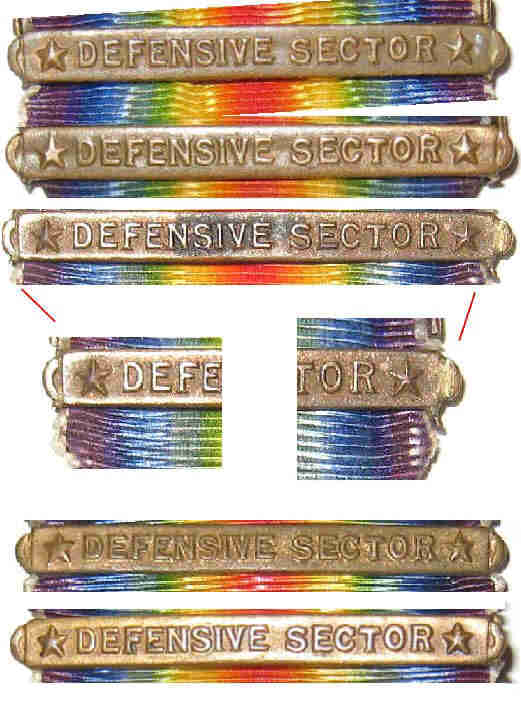 0
0 -
This picture won't give you much more than the general shape of the hallmark (if it's not just a ding). There's no detail or relief discernable at all within the diamond shape. No sign of a hallmark on the ring, edge or elsewhere.
This is just a starting point: There are many units who received the three clasp you show inyour listing. One of these units is the79th Division. was made up of mostly National Guard units from Maryland &Pennsylvania. In the 79th Division therewere 3 Machine Guns unit assigned to it:
157th Infantry Brigade, 311th Machine Gun Battalion
158th Infantry Brigade, 312th Machine Gun Battalion
Divisional Troops: 310th Machine Gun Battalion.
Is this the right the unit you are looking, I do not know, but as I said, its a start. The 79th had a bookprinted on it action and the members names might be in it.. check your local Library or ask them toorder it from the main Library.
Regards, JohnnyMac (JM)<br style="mso-special-character:line-break"><br style="mso-special-character:line-break">
0 -
To all, I need to find
The "Gleim Medal Letters 1971-1997", Extracts D35 & D36 and these two pages 88-89.
Would someone please post these.
Thanks, JohnnyMac (JM)
My son was able to find my book in storage boxes at his home,
Thanks (JM)
0 -
To all, I need to find
The "Gleim Medal Letters 1971-1997", Extracts D35 & D36 and these two pages 88-89.
Would someone please post these.
Thanks, JohnnyMac (JM)
0 -
Changing subject for moment
To all,
Need a little help here,
This is my own Navy medal (A) and as you can see it has an official ribbon and clasp. Also you can see that the thread colors flow continuously from one side to the other and it shows proper aging.
But, (B) I have been seeing more and more of this broken thread type ribbon on Vic's with official clasps on them. All example I have seen show corner wear but not true aging.
My question is, is there any info on this ribbon.
Thanks Johnnymac (JM)
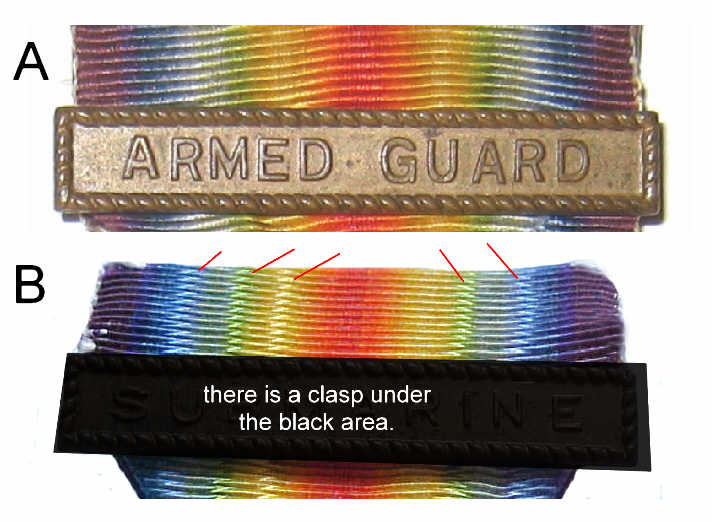 0
0 -
Hello Tim,
In regards a copy with the 'Kristesko' stamp; yes there is definitely such a type.
I will be a bit vague lest I contribute to the education of the fakers that may be out there. Specifically; the 'Kristesko' mark is in raised relief instead of the letters being incused as on the official vic.
It is most often seen on some of the online auction sites and is euphemistically sold as an official piece or even as a 'modern repro'.
Hope this helps.
Regards,
Rob
Hello Tim
I did this in a black and white to help you see it a littler clearer. And I agree with all the Rob just posted on the Romanian Vic.
Johnmymac (JM)
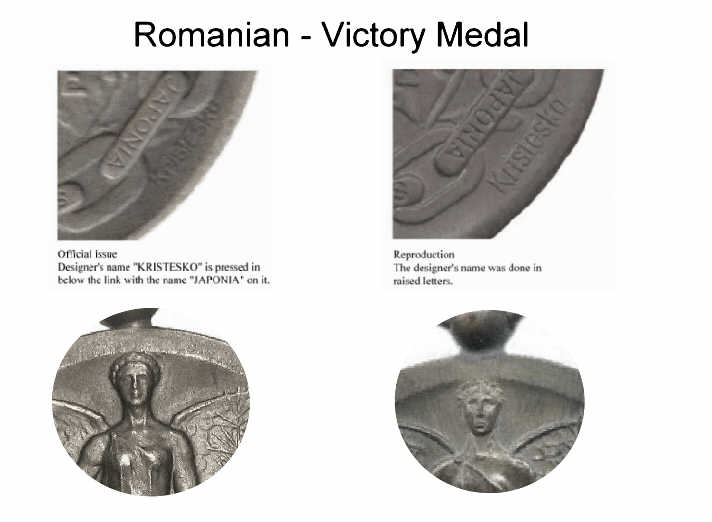 0
0 -
' alt='' class='ipsImage' >
Thanks for the comments eyeryone, it's nice to know the ribbon is a little different than standard. The opposite side of the ribbon is cleaner and therefore shows the colouring a little better.
Kev, I think I'll probably leave the brooch in it's grubby state, it looks much better in the hand than in the photo.
I'll post the conduct sheet for the Brit. VM soldier in the commonwealth forum over the weekend if anyone's interested in reading it.
Below is the cleaner side of the Czech ribbon.
Tony
' alt='' class='ipsImage' >
0 -
To those US vic collectors who participate on this thread,
Here are some pics of some engagement (battle) clasps to the US vic. Some collectors have suggested that these were produced in France but the collectors who I have corresponded with in France do not agree.
There are no markings on the reverse backstrap or reverse of the bar itself, as is usually the case with items produced in France, and there are file striations on the top and bottom edges of the bar showing signs of manufacture. The stars and font used are not consistent with French manufactured items.
Do any US collectors have any idea as to the background to these bars?
Regards,
Rob
To Rob,
If the French collectors do not feel that they are French made, then who do they think made your style clasps? If you examine my photo you will note that all three clasps have different type stars yet all three are of the same quality, and the same lettering style. They are not Bailey, Banks, & Biddle Co., as they stamped everything with their hallmark. They are not U.S. issue nor are they from the U.S. Mint. So that leaves us with either Czech or maybe Italy if they are not French made. We know that the French were producing early repros of the battle and we know they also did a series listing unauthorized campaign clasps for sale to the Veterans, mainly U.S. Veterans. Looking at Laslo's U.S. Repro 1a, figure 118, page 86, I found that these clasps plus this medal might be a good match as I have both the medal and the clasps. When you put them side by side you can see the color and the quality are the same. Is this the final word no but I feel it is a good place to start.
JM
Question is Alex Laslo still alive and if so, does he have a web site.
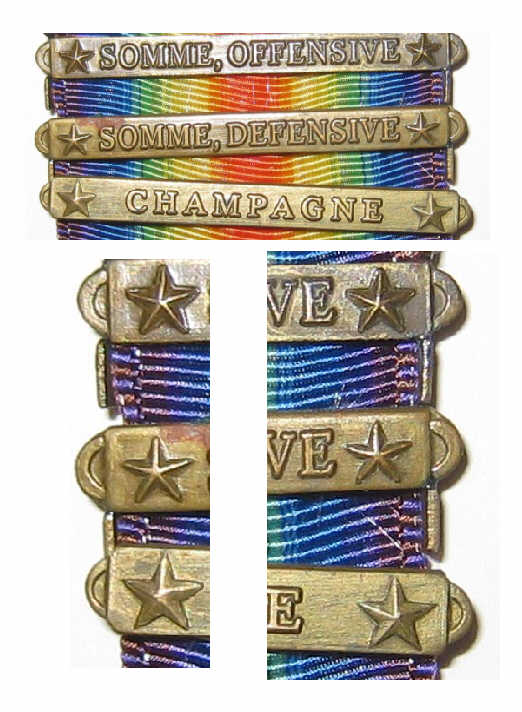 0
0 -
Off subject just for a moment.
To All
I need some help on identifying: 1) The other collar insignia next to the collar disk with crossed cannons. 2) Also the eagle to the right of the Victory medal. 3) Last the medal to the left of the Victory medal and the 2 ribbons above.
I just purchased this photo and it is signed by a Sgt. Alex Arch, 6th Field Artillery, 1St Division. He was credited pulling the lanyard on a French 75mm and firing the first U.S. Artillery piece in WWI for the AEF.
Thanks JM
http://gmic.co.uk/uploads/monthly_06_2010/post-8368-127689646284.jpghttp://gmic.co.uk/uploads/monthly_06_2010/post-8368-127689647636.jpg0 -
I am changing subject for moment. I believe there is a Japanese Vic repro on ebay which someone filed the ball suspension down to make it look like a barrel shape suspension. It has a cut off repro ribbon, and if you do a zoom in on the reverse you too might notice it. I am sure the dealer has not seen it or he would have mentioned it. Auction off ending in 5 days. Today is May 23. Check it out by typing in "victory medal", "worldwide" and let me know what you think?
JM0 -
Johnny,
I think we are probably thinking along the same lines on the seller here. The seller carefully chose his wording in the write-ups in order to separate himself from the items; calling out that he thought everything was original as it came from an advanced collector, etc, etc. Makes me suspicious immediately, and especially when you see so many fakes thrown in. Add to that, the finish on a couple of these, namely the Romanian and Portugese pieces, looks artificial and deliberately added to age the pieces. Again, only my opinion here.
I assume, you are thinking along the lines that the seller and owner are in fact the same person. I know I do and agree that the "advanced collector" would have just as easily listed these himself and known full well of the authenticity of each piece. Perhaps he doesn't do ebay, or just wanted to distance himself and his name from these???
I don't put much into ebay's individual's total numbering system, as people have multiple accounts and have closed and reopened accounts under new names. I often wonder how many proxy bidders or "friends" come in to bid the price up. I also see A LOT of bidders price auction items up with no intention to ever buy anything, just to have fun making others pay through the nose. Time will tell if any of these get relisted or second chance offers go out, but there were common bidders to several of these items. I always suspect bidders with low numbers bidding high prices and especially if they have (0) by their names.
Laslo's book is, as you pointed out, not perfect. However, it is still the best reference out there IMO, and anyone having access to it, or serious enough in collecting these medals should have enough resources available to tell real from fake. Gathering good photos of original medals is the best method and using a good reference with photos should prevent making these kinds of mistakes. So, I don't have much simpathy for these people.
If the buyers were legit, it will be another example of needing to do your homework first and buy the piece and not the seller's "story".
Regards,
Tim
Tim
I do agree with all that you say. When I bid on an item I always ask for a better photo, if the item is not shown properly, but in this case it was as plain as day. Last, I will add the seller did give them a way out with his great photos. But on the other hand, might it have been his way out “Hey, I sent you what I posted”!
Regards (JM)
0 -
Hello Tim,
Both this Romanian piece and the following Portugal piece are outright fakes. Some more generous collectors would probably describe them as modern reproductions, which they are as well, but in this case they are marketed and sold as the original piece. Both of these examples, as well as most of the vic series are the result of a well known (in some circles) US person who has been producing fakes of many medals; not just the vic series.
The give-away on this piece is the crudeness of the obverse strike as you identified, and the raised KRISTESKU mark on the reverse. There are other specific errors in both this and the Portugal strike but I shall not list them here as it will only aid the fakers if they are present amongst us!
Hope this helps.
Regards,
Rob
To All
First – The bidders were mainly new collectors, with bids on ebay as low as 9, 77, and 180. The one with 180 bids paid the outrageous price on the bogus Romania & Portuguese medal. One bidder, who has 3475 bids on ebay, did bid $256.55. This I do not understand, unless of course he had won and then changed his mind, there is the "second offer thing on ebay", if you get my point.
Second – The seller "did" list some correctly. But check out the item description on each medal sold by this seller on this group. He did a copy and paste on his whole full page Ad. But in the "item description", in some medals a key word or two is missing, like in the case of the Portuguese and Romanian, which tell me a lot.
Third – The two Questions I asked myself, would not the 50 year collector have told him which ones were good, and which ones were not? And why, did not, the 50 year collector auction them himself?
Forth - The Romanian and the Portuguese medals may have been driven but the lack of the availability of Laslo's book.
Fifth - I hate to touch on Laslo's book, but he put so much time into his writing and not enough time in his photographs. How many times have we heard that old saying "A picture is worth a thousand words". A new collector even with Laslo's book may not see the fine lines between official, reissue, unofficial and in some cases "Repros"
Last - I can where new collectors trusting a seller with over 5700 sales, selling a 50 year collector's collection might go wrong.
At least this time it was not "Estate Sale", chuckle, chuckle.
JM (Johnnymac)
0 -
Hello All -
Again, "it has been awhile" since my last post, but I had followed your thread on your Romanian group of 9, Rob. A very interesting discussion. I very much agree with your comment - "a bit of intrigue with a group is a good thing sometimes". I tend to learn more from the groups that have perhaps been fiddled with than the genuine straight forward ones ....
My addition to the Victory thread here is I need some help in clearing up the abreviations on this WWI pair I have just purchased. I bought them purely for the naming - I have not seen it before. It is a South African's duo - J W Harte
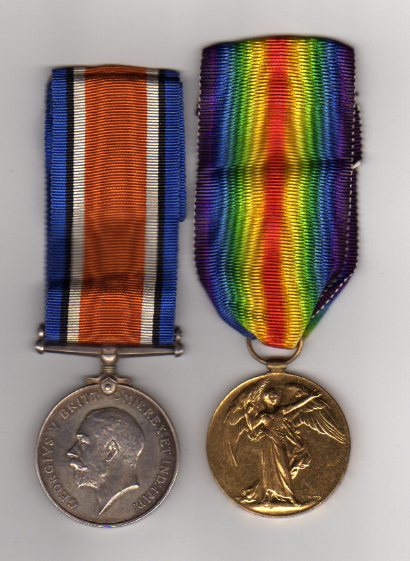
and the naming is as follows C.Q.M.S. J.W. HARTE. C.C.L.R.
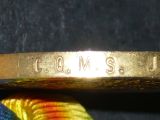
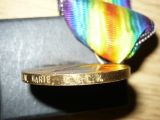
Any help here would be very much appreciated.
regards
Thomas
CQMS - Company QuarterMaster Sergeant
0 -
There seems to have been a large market in France for uniface medals because tens or hundreds of thousands of vets had their medals mounted in Frames with big service certificates. Often this was a second set of medals while the originals were kept to be worn. To make the mounting in the frame under glass easier the backs of the medals were sometimes removed (eg. on the CDG).
I assume the uniface were easier to mount and were often used in frames..
Best
Chris
Hi Chris
The thickness of the ribbon itself, plus the ball suspension overall width, would negate the need for a uniface medal (reverse side) to fit into a frame. Might it be just a supply of M. Pautot surplus medals sold on the open market? Or, an enterprising person, or M. Pautot himself who saw a large market with the veterans who might want a framed medal? Left blank as it is, it seems to me that a veteran could have some inscription put on it, like a name, battles, dates etc. and that in itself would be a big marketing tool for this type of medal. L. O. Mattei found a market for his half of the unofficial type 2 medal "listed in Laslo's" book" by using it for shooting match medals "Concours De Tir" held in France during early 1920's.
See illustration of L.O. Mattei medal below
regards, Johnnymac (JM)
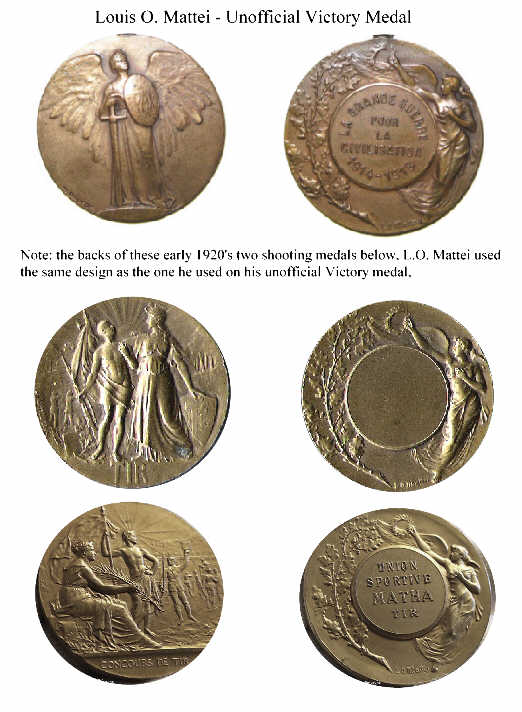 0
0 -
Hi,
As a point of clarification are the following clasps Navy Service authorized, In this case including the France clasp? "The U.S. Navy issued similar service clasps to the Army for service in the following regions during the following periods: (Wikipedia)
- England (April 6, 1917 to November 11, 1918)
- France (April 6, 1917 to November 11, 1918)
- Italy (April 6, 1917 to November 11, 1918)
- Russia (November 12, 1918 to July 31, 1919)
- Siberia (November 12, 1918 to March 30, 1920)
- West Indies (April 6, 1917 to November 11, 1918)"
thanks, Bosungus
Hello Bosungus
SEA DUTY
RUSSIA and SIBERIA: "For service on any vessel" which made a Russian port during such service from 06 April 1917 to 11 Nov. 1918, or any combatant ship in a Russian port on the White Sea not less than 10 days from 12 Nov. 1918 to 31 July 1919.

SHORE DUTY
Up to 1933 the naval personnel on shore duty in Russia & Siberia were only awarded the Victory medal, no clasp/bar. In 1933, the Navy extended the "Army's" Russia and Siberia service clasps to naval personnel, "For service on shore" in Northern Russia & Siberia, from 12 November 1918 to 31 July 1919.
Does this help, JM (JohnnyMac)
0 -
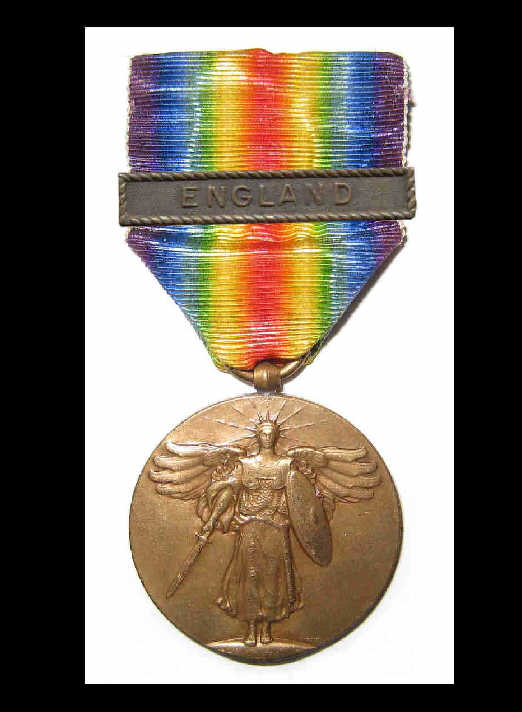
Thanks for the information. I ask because i saw a WW1 US Navy Victory medal on Synderstreasures
that had the Aviation & France bar yet I could not find any reference for the France authorization.
http://snyderstreasu...ctorymedals.htm
Would this be a later add on?
Thanks, Bosungus
Hello Bosungus
Here is another one but of England
Regards JM (JohnnyMac)
0 -
Question:
Did the US Navy issue a France clasp for WW1 US Victory medal? I noticed an Aviation clasp along with a France clasp on a WW1US Victory medal
and wonder if the France was an authorized clasp.
Thanks
Here some of my notes I keep, I hope it helps:
This clasp is a Gleim FI type (Unknown Manufacturer) and as of this date there is no information on it being an authorized clasp.

NAVY SERVICE CLASPS
Bureau of Navigation Circular Letter No. 36-20 of 23 April 1920 announced provisions for issuing the Victory Medal, adding that honorable character of service was a precondition for award of the Victory Medal. Recipients were authorized to have engraved on the rim his or her name, rank and the name of the ship or station where he or she served during the war, (There are many examples of the engraving on the face of the medal, which is obviously a misunderstanding of the owner or the engraver of the stated order).
In 1933, the Navy extended the (Army's) Russia and Siberia service clasps to naval personnel for duty in the following timeframe:
RUSSIA: For service on shore in Northern Russia from 12 November 1918 to 31 July 1919. SIBERIA: For service on shore in Siberia from 12 November 1918 to 30 March 1920, both Army style clasps
Seven years later, on 05 October 1940, the Secretary of the Navy authorized the award of the (Army's) FRANCE, ENGLAND and ITALY service clasps to personnel of the Navy and Marine Corps who sailed from the U.S. prior to 11 Nov. 1918 enroute to one of these countries, regardless of their date of arrival in that country -- even if those personnel were returned to the U.S. without disembarking.
The first formal assignment of clasps was contained in General Order No. 528 of 25 April 1920. Curiously, it also made reference to clasps HOSPITAL SHIP and GUNBOAT, devices never authorized or officially struck. By 1953, the Navy and Marine Corps Awards Manual specified clasps for approximately 1,388 ships, 140 of these vessels qualified for two different clasps and two ships qualified for three clasps. Again, a recipient could wear only one earned Navy clasp.
The thousands of Marines and Navy Medical Corps personnel attached to the Army in France earned and were authorized to wear those (Army) clasps authorized by their parent command.
When any person had been commended as the result of the recommendation of the Board of Awards by the Secretary of the Navy for performance of duty during World War I not justifying the award of a Medal of Honor, a Distinguished Service Medal, or a Navy Cross, he or she shall wear a 3/16-inch silver star on the suspension ribbon and ribbon bar for each such citation.
A bronze Maltese cross, 3/16-inch in diameter, was to be placed on the service ribbon of those officers and men of the Marine Corps and Medical Corps, United States Navy, who were attached to the American Expeditionary Forces in France any time between 6 April 1917, and 11 November 1918, and who are not entitled to any battle clasp provided for by General Order No. 83, War Department, 30 June 1919.
JM
0 -
Tim,
PM sent.
Rob
To All,
Battle Participation of Organizations of the American Expeditionary Forces in France Belgium and Italy 1917-1918 (Paperback)</SPAN> $16.98 USD
http://www.amazon.co...64678834&sr=1-1
JM
0 -
Hello Tim,
Call me old fashioned but I prefer the 'dead tree' variety. I find it easier if I have to constantly refer to something, to be able to turn around, reach to my references on the bookshelf, and peruse them in a meandering sort of way.
The exception to that rule is my barely recognisable 2nd Edition of Mr Laslo's book. There is only so much emendation that can be done on a paper copy of a book before you turn to keeping the additions in electronic format.

Rob
To All;
Both books are Government printing, both printing dates 1920. Second book by Gen. Pershing: list all units attached to 1st, 2nd 3rd., Army, and their Corps, Divisions, Battalions, Regiments, etc.
Example: these unit not list in book: Battle Participation --------etc.
1st DIVISION
1St Mobile Ordnance Repair Shops (M.O.R.S.), 301st, 378th & 695th Service Parks, 1st Motor Vehicle Shops, 309th Commissary, 319th Clothing, 22nd Salvage, 314th Laundry, 18th & 22nd Bath, 7th Bakery.
2nd DIVISION
2nd Mobile Ordnance Repair Shops (M.O.R.S), 303rd, 363rd & 375th Service Parks, 2nd Motor Vehicle Shops, 1st Commissary, 320th Clothing, 2nd Salvage, 326th Laundry, 17th Bath, 319th Bakery.
It is the mate to Battle Participation, ------------etc. not only does it list ALL the units, it has tons of maps, each battle and more. Sorry this book is not a reprint so keep an eye out.
Forget downloading and printing the book out. Cost of ink is a killer, not mention time or paper! Book is only $19.95 USD.
JM
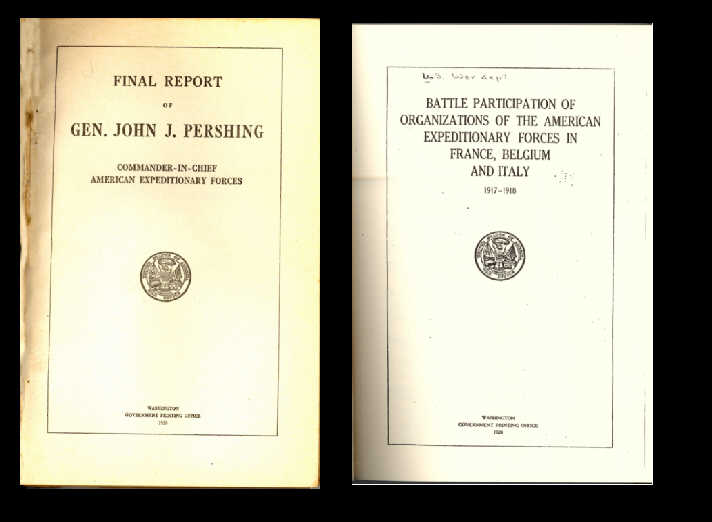 0
0



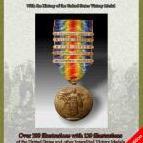

Italian Victory Medals
in Inter-Allied Victory Medals of the Great War
Posted · Edited by johnnymac
Of course you would use the word elitism, who else would have wasted millions of lives. Elitism is the belief or attitude by individuals who are considered themselves members of a select group of people with superior intellect and wealth.
The Officer Corps was made up of mostly wealthy families who conceded "themselves" the "elite". Besides who else in that time period would have purchased a medal gilded, plated or made of solid silver to just enhance it.
In the U.S.A. many when to Bailey, Banks and Biddle for the same reason.
Rob, Thanks for the info and come back
JM